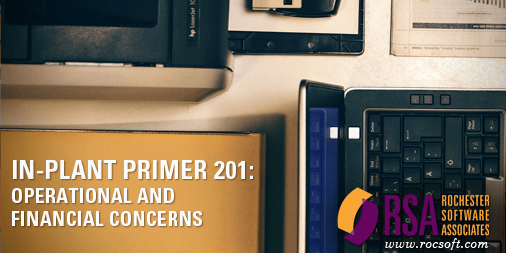- Howie Fenton
- |
- September 22, 2017

This article is part of our dealer and vendor in-plant education initiative called "In-Plant Primer: From Operations Basics to Advanced Sales Concepts." Divided into six basic (101) and six advanced topics, this is the third post of the advanced in-plant primer series, "In-Plant Primer 201: Operational and Financial Concerns." In this advanced portion of the primer series, we're covering topics like vertical markets, financial models, management and administration views of in-plants and more. Access your RSA partner resource portal to download the two series eBooks or listen to the August 23 webinar recording about all the topics.
Key Take Aways
- Commercial printers often discuss sales, marketing, and profitability, but the in-plant community generally frowns on those terms and conversations.
- In-plant managers are more concerned about day-to-day operations and their language and what motivates them is consistent with that language (print quality, on-time delivery, productivity, lower risk, policing the brand or compliance issues).
- C-Level executives focus more on financial considerations. Their language and what motivates them is based on achieving their financial goal (i.e., breaking even, making or saving money), reducing staff, achieving a return on investment, etc.
Using the Wrong Language with an In-plant Can Result in Being Shown to the Door.
There are books written on the good and bad language to use in sales calls. For example, on the Amazon web page promoting the book, The Secret Language of Influence, the description reads, "Saying the right word can transform an awkward sales call into a comfortable conversation or a resistant prospect into a happy customer." On the Liz Wendling web page promoting her book, Watch Your Sales Language: Five Things to Avoid on a Sales Call, it says, "To become a lean, mean, selling machine means ridding yourself of the words and phrases that repel buyers. It means freeing yourself of the language that diminishes your power and decreases your credibility. Start speaking the language of sales success." However, those books are general sales books and don't discuss specific industry jargon to avoid or include in your conversations. The consequences for using the wrong industry-specific word are more significant. It's important to understand that the language used by a commercial printer is somewhat different than the language used by an in-plant printer. Also, worth noting is that depending on someone's position in the in-plant, the day-to-day concerns and the language used can also be different. Using the wrong language can lead to the customer thinking you don't understand them or their market, and at worst could result in being shown the door.
Commercial Printer VS In-Plant Language

When working with commercial printers, it's not unusual to talk about sales, marketing, and profitability. Unless you hear an in-plant manager use these terms you should avoid them because they are frowned upon. In general, in-plants are designed to provide service to their customers and not make money in the process. In the different business models discussed earlier, only the revenue-generating and model is designed to make money. All the rest (fully funded, partially funded, and breakeven) are not designed to make money. That is why, within the in-plant community, different expressions are used to discuss their sales and marketing efforts. Expressions such as open houses, pizza lunches, "How To" classes, and free training are often used to reinforce relationships, identify new customers and learn more about their needs.
Different Internal Language
In-plant print center production managers often report to someone in administration. While it's not possible to predict which department an in-plant reports to, we can say that the in-plant manager reports to someone that we will call a C-Level executive. The concerns of the production manager and the C-Level executive are vastly different, and their language often reflects this difference. Frequently the manager is a working manager and responsible for scheduling, compliance with regulations (i.e. HIPAA), data security, and on-time delivery. In contrast, the C-Level executive is focused on financial responsibility, such as year-to-date progress toward achieving the financial goal (i.e. breakeven), FTEs (full time employees), or the return on investment for new hardware or software. The next time you talk with an in-plant manager or administrator, think about the language you use with them and avoid using terms that their commercial counterparts use. In our next 201 primer article we will talk about how in-plant managers and administration may look at the in-plant differently and how different approaches and value propositions are sometimes needed with these different audiences.
Never Miss an Article Again. Subscribe and Learn!
Don't miss any blog articles; subscribe to RSA's email updates and we'll automatically alert as each article is published.